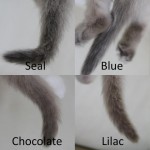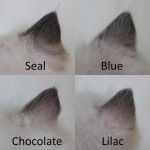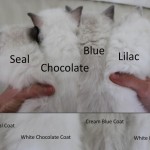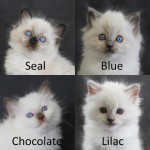Ragdoll Info
From our experience the Ragdoll is placid, calm, yet moderately active, loves to play and has an exceptionally loving temperament. With their easy going attitude they get along really well with children and other animals, and although they are a quiet cat they can be extremely curious and always inquisitive - wanting to know what you're doing and where you're going, to the extent of having a personality that is 'puppy-like' in nature.
About this breed:
Ragdolls are a large breed of cat with very laid back, gentle and playful natures that have a semi longhaired coat and captivatingly blue eyes.
The Ragdoll cat is carefully bred to produce large affectionate cats that are very easy to train, very social and also very nosey. Ragdolls are a very popular choice of pet due their affectionate and friendly nature, and are often referred to as the ‘puppy dog’ of the cat world.
Ragdolls are the purr-fect companions as they are very social and adore people. Because ragdoll cats tend to be more interested in humans than some breeds, they generally choose to be where you are, and want to be involved in everything you do, so they are known to run to the door to greet you, follow you from room to room and just love any attention. They love to fall asleep on you and sleep with you in your bed.
They are a large muscular build and you can expect de-sexed male ragdolls to weigh around 6-10kgs and de-sexed females weighing between 4-8kgs when fully grown.
Health wise Ragdolls are a very hardy breed and rarely require medical attention. You can expect your Ragdoll cat to live to the age of around 12-15 years.
Ragdolls are gentle and docile cats but are also love to play, and usually play without ever extending their claws. Ragdolls remain playful as adults and will pick up toys in their mouth and carry them around making them very entertaining and they get on very well with other animals – especially dogs.
Ragdolls are the perfect companion cat for older people due to their loving and friendly nature, and they’re a good choice people who love the longhaired look without wanting to devote too much time to grooming, as they are not high maintenance. Of course they make fabulous family pets as they are great with children and love to be handled and cuddled. They go limp and floppy when picked up - hence the name ‘rag doll’. Ragdolls also tend to be floor cats, not jumpers.
Ragdoll cats are gentle, loyal and extremely affectionate, making them a truly irresistible and wonderful addition to any family.
History:
There are many controversies and lots of different stories about how the Ragdoll Breed originated, but what we can say and know for sure is that the Ragdoll has continued on the desired traits for over 50 years –with Ragdolls known by cat lovers all over the world for being a very friendly, generous sized cat with a gentle, docile and floppy but playful nature, beautiful plush tangle-free fur, and of course the most stunning blue eyes.
The story of the Ragdoll is one shrouded in mystery but here is the story of what we do know about this magnificent breed:
Ragdolls originated in the 1960’s in California by an established breeder Ann Baker, who created the Ragdoll breed by selectively breeding Josephine, her domestic Angora-type longhaired white female to various male Birman, Burmese and Persian/Angora look alikes – one of which had Siamese point colouration.
The offspring of this female had unique temperament traits that were very endearing. Ann believed she has something special so by selecting individuals with the look, temperament and criteria she wanted for her breeding programme, she set out to achieve the desired result of what is now known as the Ragdoll.
The breed was selectively bred over many years for desirable traits, such as large size, gentle demeanor and a tendency to go limp when picked up as well as the beautiful colouration and of course their stunning blue eyes.
There are only a few foundation Ragdolls that we know about: Josephine, Blackie (a black/brown Birman- like male), Raggedy Anna Daddy Warbucks (a seal point with white feet), Fugianna (a bi-coloured female) and Buckwheat (a dark brown/black Burmese-like female). Both Blackie and Daddy Warbucks are both sons of Josephine but with different sires who were unknown and undocumented. IRCA records appear to indicate that Blackie’s father was a black cat from the East and appeared more Persian than Burmese.
All Ragdolls are descended from Baker’s cats through matings of Daddy Warbucks to Fugianna and to Buckwheat. She trademarked the name “Ragdoll” and set up the International Ragdoll Cat Association (IRCA).
The RAGDOLL was first recognized as a pure breed in the USA in 1965. Following that achievement Ann did nothing more to futher the Ragdoll in the fancy.
Fortunately, a group led by a husband and wife team, Denny and Laura Dayton (Blossom-Time Cattery) who had purchased a pair of kittens in 1969 from Ann Baker, started a long campaign along with other breeders who had purchased breeding pairs off Ann, to get the Ragdoll breed onto a sound genetic footing and worked to hard on getting Ragdolls accepted by various cat fancy associations so the breed could be shown.
In 1975 Denny Dayton, Blanche Herman (a breeder) and ten pet owners attended a CFF Show in Ohio. The final outcome was that they were granted championship status in all patterns. As a result of all their hard work the Ragdoll was now recognized in cat fancy and could finally be shown. With great excitement the Ragdoll Society was founded in 1975. This group eventually developed the Ragdoll standard currently accepted by major cat registries today.
This was later changed to the name Ragdoll Fancier’s Club and finally to the present Ragdoll Fanciers Club International (RFCI). The RFCI was established to promote the Ragdoll Breed in the biggest associations so that Ragdolls could be shown more widely. It is still the oldest still existing Ragdoll breed association in the world today.
Personality:
Ragdolls have the most endearing personalities. The common traits that make the Ragdoll such a popular and lovable breed is their docile, gentle and playful natures. They are a loving, quite cat with a very laid back disposition.
The Ragdoll is a relaxed, happy cat and aptly named ‘rag doll’ they go all floppy when picked up will go limp and flop in your arms like a child’s rag doll when picked up – collapsing into an armful of blissful beauty!
Ragdoll cats crave attention and affection and are known to run to greet you at the door, follow you room to room, flop on you, sleep with you and generally choose to be where you are. Many Ragdolls have been taught to come when called and play fetch and are often referred to as ‘puppy dogs’ of the cat world.
The Ragdoll personality is exceptionally gentle and easy going, they love children and other animals, are well behaved and easy to care for – making a great choice for a wonderful family pet.
Ragdoll Colours and Patterns:
Ragdolls are pointed cats. Ragdoll kittens are born white and their colours and patterns start to show when they are about 10 days old.
Ragdolls continue to get darker with age and don’t reach full maturity in colour or size until around 3 years of age.
In most associations, Ragdolls are accepted in 4 colours and 3 patterns. The four colours are "seal", "chocolate," "blue", and "lilac".
The three patterns are "colourpoint", "mitted", and "bicolour".
We breed Ragdoll Kittens in all four colours - Seal, Blue, Chocolate and Lilac, in all three of the basic patterns – Pointed, Mitted and Bi-coloured.
Colours:
SEAL – Have very dark brown, almost black coloured points with a light tan body colour.
BLUE – (SEAL dilute) Have dark blue-grey points with a pale grey body colour.
CHOCOLATE – Have milk chocolate points with an ivory body colour.
LILAC – (CHOCOLATE dilute) Have pinkish/mauve/grey points with a frosty white body colour.
Patterns:
POINTED - Have dark points (ears, tail, face, and feet) with just one colour on the body of a lighter shade. The nose leather and paw-pads match the point colour. Colour points do not have white markings (although the pale body colour may appear white on some cats).
MITTED - Have dark points and lighter body like a color point, but also has white "mittens" on the front paws, white "boots" on the back legs and feet, a white chin, a white strip on the stomach, and a white ruff.
BI-COLOUR - Have the dark points (ears and tail), but the mask is interrupted by an inverted "V" running between the eyes and expanding into the muzzle. The body colour forms a "saddle" on the cat's back and the remainder of the cat is white. Bi-colours have pink nose leather and paw-pads.
To describe a Ragdoll, combine the colour and pattern names.
For example, a seal Ragdoll, depending on the pattern, might be a "seal colour point," "seal mitted," or "seal bi-colour."
Here are photos showing these four colours.
Photo credit and thanks to Michelle Thackwray for these photos
Health & Grooming
Ragdolls are generally healthy cats and live to be an average of 12-15 years old.
You have peace of mind when purchasing a Fanfare Ragdoll Kitten that they are free from any particular diseases, are up to date with worming and vaccinations, have received a full Vet Check and are de-sexed before they go to their forever homes.
The health of our Cats and Kittens is of utmost importance and visiting is welcomed but strictly by appointment only.
No one may visit our home if they have been to another cattery, pet store, shelter etc. on the same day and we are sure you’ll understand that you wouldn’t want to risk the health of your new potential kitten or any young babies or expectant mothers.
We DNA test for HCM and PKD and have also tested new breeding cats bought in for FIV and FeLV and all have been Negative.
We are a CLOSED CATTERY. We do not provide Stud services or have visiting cats come and stay. This ensures the health and well being of our Ragdolls.
FAQ’s
Is the Ragdoll breed the cat for me?
If you want a large cat which is non-aggressive, loves to be with people, and is very placid, playful and wants to be your new best friend, you may want to consider a Ragdoll.
Are Ragdoll cats good with children?
The gentle Ragdoll are fantastic with children. Our kittens are raised around our children so they are used to being handled every day. Besides – Ragdolls thrive on attention and LOVE being played with.
Are Ragdoll cats good with other animals?
We have maltese dogs and our cats and kittens get on wonderfully together. Ragdolls are a very easy cat to introduce into a multi-pet household.
What is the life expenctancy of a Ragdoll?
Ragdolls are not considered different from any other cat when it comes to life expectancy. With proper care and a balanced diet, a Ragdoll can live to be anywhere from 15 to 25 years old.
At what age is a Ragdoll full grown?
A ragdoll is not considered to be mature until they are 3-4 yrs old.
Are they easy to care for?
Ragdolls do not shed excessively, and need little care to keep their coats in good condition. Their soft, rabbit-like fur does not tend to mat. If you love the look of a long-haired cat, but do not want the constant grooming associated with breeds such as the Persian, a Ragdoll would be a good choice.
Can we come and visit our Ragdoll kitten?
Yes you will be invited to visit your kitten and we do allow people to come and view our Ragdolls as we believe it is important for potential buyers to see how much love and care we put into our cats and how they are cared for and where they live. However I do not allow very young kittens to be handled as the health of our cats and kittens is of upmost importance.
Are they easy to train?
Ragdolls are intelligent and like to please their owners. Training Ragdolls is much more successful when done with rewards. For example, they can be trained easily to use a scratching post instead of your furniture by lavishing attention on them whenever they use the post. As with most cats, however, Ragdolls can be their "own boss" if they so choose!
Ragdolls can be easily leash trained so that they can go for walks with you outside.
Is the Ragdoll an indoor cat?
Your ragdoll will want to be with you and will be most happy following you around indoors. Due to the docile and gentle nature of the Ragdoll – they lack the instinct to defend themselves when attacked so they must be kept as indoor pets and if they follow you outside keep under close supervison.
What colours do Ragdolls come in?
Our Fanfare Ragdolls come in six colours of Seal, Blue, Chocolate, Lilac, Red (Flame) or Cream.
The rarest colours are Lilac and Chocolate which are harder to breed.
At Fanfare Ragdolls we breed Seal, Blue, Chocolate and Lilac Ragdolls.
One kitten or two?
Ragdolls are generally sociable cats and love having another feline around for companionship. If you already have a young cat or dog in your household they will be great company for each other.
If you are looking at adopting a Ragdoll and are considering getting two from the same litter this is probably a good idea. Having two littermates grow up together can be a fun experience! They will have company and a constant playmate at all times. My Ragdolls get on great with our Maltese dogs and puppies.
Are there any health risks for the Ragdoll breed?
Ragdolls are a hardy breed and require little medical attention other than keeping up to date with vaccinations, worming and flea treatments. Our Fanfare Ragdolls are DNA tested to be free from HCM and PKD guaranteeing the health of our Ragdolls.
Male or Female?
The boy will grow bigger than girls but there is really not much difference between. Spraying only becomes an issue when boys are left entire and there are females around and he wants to breed with them, however as your kitten will be de-sexed before it leaves our home, there shouldn’t be any problems so it really doesn’t matter what sex you prefer. Its all about your personal preference as to whether you choose to get a boy or a girl Ragdoll kitten.




